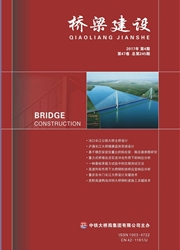

 中文摘要:
中文摘要:
为研究中、美、英规范在跨海大桥桩基波浪力计算方法上的差异,对我国《港口与航道水文规范》(JTS 145-2015)、英国《海工规范》(BS 6349-1:2000)和美国《海岸防护手册》(EM1110-2-1100)中小尺寸桩柱波浪力的计算原理、适用范围和参数进行对比,并以平潭海峡大桥为例计算其桥墩桩基的波浪力。研究结果表明:中、美、英三国规范小尺寸桩柱波浪力计算均采用莫里森方程,速度和加速度均依据线性波浪理论确定,但由于计算方法不同,各国规范在适用范围和参数(静水面以上波峰高度、最大总波浪力和力矩、阻力系数和惯性力系数、修正系数)存在差异;虽然各国规范波浪力计算结果存在差异,但随着波浪参数的变化,其结果变化规律一致且稳定。
 英文摘要:
英文摘要:
To study the differences of the calculation methods for the wave forces of pile foundations for sea-crossing bridges provided in the Chinese, American and British codes, the calcula- tion principles, applicable ranges and the parameters of the wave forces of the small size piles in the Chinese Code of Hydrology for Harbour and Waterway (JTS 145-2015), the American Coastal Engineering Manual (EM 1110-2-1100) and the British Maritime Structures: Code of Practice for General Criteria (BS 6349-1 : 2000) were compared, the pile foundations for the piers of the Pingtan Straits Bridge in China were taken as the examples and the wave forces of the pile foundations for the bridge were calculated. The results of the study demonstrate that in the codes of the three countries, the wave forces of the small size piles are calculated all by the Morison equation and the velocity and acceleration are determined all according to the linear wave theory. Because the calculation methods of the three countries are different, the applicable ranges and the parameters (e. g. the wave crest height above still water surface, the maximum total wave force and moment, the drag force and inertia force coefficients and the correction coefficients) have differences. Though the differences exist in the calculation results of the wave forces according to the codes of the three countries, the changing laws of the calculation results are consistent and stable with the changing of the wave parameters.
 同期刊论文项目
同期刊论文项目
 同项目期刊论文
同项目期刊论文
 期刊信息
期刊信息
